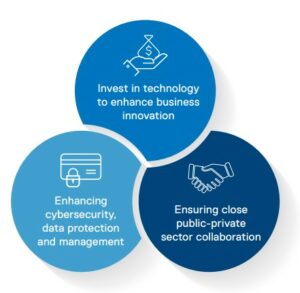Technology advancement is a key measure of economic growth. It can kick start economies. Its injection is necessary now—to recover from a tough couple of years.
In the wake of the pandemic, it’s becoming clear that parts of Asia Pacific & Japan (APJ) have demonstrated tremendous resilience. High performers are rebounding quickly. However, the outlook varies across the region. Economies have been recovering at differential speeds. It’s no coincidence that the take-up of new technologies, to manage the COVID-19 pandemic, also diverges.
On one end of the spectrum, 52% of the region’s 4.3 billion people remain offline with no access to such innovations, according to a study by the United Nations Economic and Social Commission for Asia and the Pacific (UNESCAP).
On the other, the region is home to some of the most digitally inclusive and advanced economies in the world. The Roland Berger’s Digital Inclusion Index ranked Singapore 1st, Australia 6th, and South Korea 7th.
Coming out of the pandemic, the public sector needs to evolve faster. The private sector cannot effectively transform without adequate support from the public sector.
—Amit Midha, president, APJ and global digital cities, Dell Technologies
As our whitepaper “Ideating through technology” observes, in South Korea an increasing number of firms are now looking to transition to multi-cloud environments. DevOps initiatives are also underway, followed by ventures into AI and Big Data. The same can’t be said for other markets in the wider APJ region. In fact, data complexity remains a stumbling block.
If this growing gap is not addressed, we risk a greater digital divide within both the workforce and society at large. So, how then can we narrow this digital divide to achieve a digitally inclusive recovery?
1. Build a blueprint for digitally inclusive recovery
Bridging the digital divide in society is a long-term process that will need to start from the ground up. As technology accelerates, we must be mindful of the gaps that can arise in these main areas:
- Access: The gap between those who have access to the Internet and those who do not
- Skills: A skills gap that cannot keep up with the pace at which technology transforms
- Growth: A gap between larger organizations that have the budget and resources to digitally transform, ahead of smaller companies
Narrowing the digital divide should be an integral part of our response to the pandemic and we must recognize that digital inclusion is a socio-economic, educational, and technological challenge that cannot be shouldered alone. The critical drivers for digital inclusion include providing affordable home internet as an essential service, access to “the right” computing devices, bundled with high quality-digital literacy content and efforts to upskill.
Each would allow people to work from home, which is a tremendous equalizer for many careers. According to Dell’s Breakthrough study with 10,500 workers around the world, 82% of respondents in APJ believe a lasting shift to remote work (the freedom to do anything from anywhere) would create a more inclusive working environment.
To deliver the necessary skills and technologies, a proactive collaboration between communities, state and local governments, public and private-sector companies and non-profit organizations is required.
2. Tech companies to take the lead in digital inclusion and upskilling
 Considering their expertise, capabilities and resources in the field, technology businesses are in a prime position to foster and meet the critical drivers of digital inclusion and nurture digital talent. From providing access to digital infrastructure to upskilling the workforce and creating jobs, tech companies can drive and enable more people and organizations to participate in the digital economy.
Considering their expertise, capabilities and resources in the field, technology businesses are in a prime position to foster and meet the critical drivers of digital inclusion and nurture digital talent. From providing access to digital infrastructure to upskilling the workforce and creating jobs, tech companies can drive and enable more people and organizations to participate in the digital economy.
At Dell Technologies, we launched Dell Aarambh – an India-based initiative that seeks to connect parents, teachers and students and provide them with the necessary training to better utilize the PC for learning, both at school and at home. The initiative has engaged close to 1.5 million students through the Dell Champs School contact program and trained and certified over 32,000 teachers through the Aarambh Training Program.
With the demand for tech skills far exceeding supply, the digital skills gap can pose potentially the biggest risk to a country’s economic success. Tech companies hold the key to driving change and the time to act is now.
3. Encourage collaboration between the private and public sector on digital inclusion initiatives
To drive the long-term success of digital inclusion initiatives, the public and private sectors must work hand-in-hand to deliver the devices, broadband and connectivity solutions, skill-building and resources that the underserved communities need.
Initiatives by the public sector are key to supporting the private sector. In Australia, for instance, the government is investing over $100 million in initiatives to build the digital skills of Australians to meet the needs of the modern Australian workplace. Australia’s research and industry capability in artificial intelligence is expected to be boosted with $124.1 million, including a National Artificial Intelligence Centre led by CSIRO’s Data61.
Singapore also launched the SkillsFuture program in 2017 to heighten the workforce’s digital literacy level, as part of the country’s vision for building a digitally-savvy Smart Nation. SkillsFuture Singapore further identified 16 Critical Core Skills to focus on the Digital Future–such as transdisciplinary thinking, customer orientation and digital fluency–to guide individuals, employers and training providers on the essential technical and non-technical skills required to stay relevant in the digital economy. This focus on digital skilling was also reinforced in the country’s Budget 2022, where the Singapore government announced that it will set aside an additional S$200 million over the next few years to enhance digital capabilities for workers and businesses.
At the end of the day, digital inclusion is not simply about providing citizens with a laptop and Internet connection. Today, people rely on technology tools to improve their quality of life, and investing in education enables nations to meet future demands and keep abreast of progress.
For more insights on digital inclusion, read our full Digital Future: A Recovery Roadmap – Inspiring a digital-ready workforce whitepaper that dives deep into key trends, opportunities and learnings that can guide organizations in APJ as they journey towards inclusive recovery in the Digital Future.


By Amit Midha, president, APJ and global digital cities, Dell Technologies